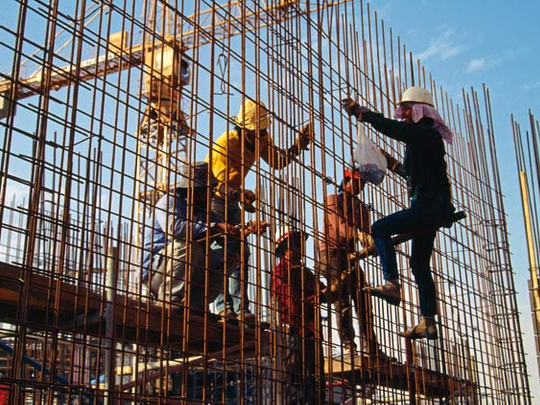
Last year was one of consolidation and recovery for the Gulf Cooperation Council (GCC) states.
The recovery has been uneven across the countries in the region, as governments tapped their sovereign wealth to varying extents to cushion the blow to their banking systems and to compensate for the weakness in private sector demand and investment.
We estimate the region enjoyed GDP growth of 4.6 per cent on average last year, a big improvement on the 0.3 per cent contraction of 2009.
Qatar was undoubtedly the relative winner, with estimated GDP growth exceeding 16 per cent largely on the back of increased LNG capacity and production. Saudi Arabia, the biggest economy in the region, enjoyed more modest growth of just under 4 per cent, while the UAE was the laggard of the GCC in terms of economic growth according to our estimates.
These three countries account for around 80 per cent of the region's nominal GDP (and, from a financial markets perspective, for 80 per cent of the region's market capitalisation).
The main contributor to growth in 2010 was public investment in infrastructure, funded by strong budget surpluses and accumulated sovereign wealth. This is likely to remain a key driver for GCC economies in 2011, and beyond.
The chart on the opposing page illustrates the jump in capital expenditure (capex) relative to GDP in 2009 for almost all the countries in the region. In our view this reflects (1) increased spending on infrastructure as governments pursued more expansionary fiscal policies immediately after the 2008 financial crisis and subsequent global slowdown, and (2) lower nominal GDP as a result of lower oil prices in 2009 relative to 2008.
Saudi Arabia spent the most on capex relative to the size of its economy, and is the only country where we expect this ratio to continue rising this year.
Oman is, surprisingly, the second-biggest capex investor in the region, relative to the size of its economy. The recent announcement of the eighth five-year budget plan, amounting some $100 billion in expenditure, underscores the government's commitment to boosting the capacity for growth.
Qatar's strong infrastructure spending commitments will be underpinned by the country's hosting of the 2022 Fifa World Cup. The ratio of capex to GDP is expected to remain flat as GDP growth exceeds 20 per cent this year and next.
For the UAE, meanwhile, the estimated capex ratio to GDP of less than 2.5 per cent for 2010 and 2011 is uninspiring. It follows from (a) limited federal budget allocation, (b) the burden in Dubai adopted instead by government-related entities (GREs), and (c) Abu Dhabi's fiscal conservatism.
However, we believe that as the economic recovery in the UAE gathers pace we could see an increase in official government spending on infrastructure in future budgets.
Financial prowess
The GCC has accumulated a substantial amount of wealth through the sale of crude oil and other hydrocarbons over the past decade. Even in 2009, with the double whammy of a lower per barrel oil price and a drop in the volume of oil exported, the GCC managed to post a current account surplus of 7.7 per cent of GDP.
Over the past five years the current account surplus for the region has averaged just over 20 per cent of GDP. Since the region had relatively little to no external debt that needed to be repaid over this time, and has consistently run budget surpluses, much of this cash has effectively been invested abroad, or saved in the form of gold and foreign exchange reserves.
We believe that the total level of gross foreign exchange reserves at the end of 2010 is higher than a year ago, and back at pre-crisis levels. Saudi Arabia's net foreign exchange reserves fell to $405 billion (Dh1,487 billion) in 2009 as the government used some of its accumulated wealth to finance the budget deficit, before rising to almost $440 billion by the end of last year, according to our estimates.
Saudi Arabia's net foreign exchange reserves are now equivalent to the size of its entire economy. We expect the UAE is in a similar strong position despite tapping its sovereign wealth fund to finance the 2009 budget deficit.
Although Saudi Arabia and the UAE recorded budget deficits in 2009 on the back of lower oil prices and export volumes, we estimate the average budget surplus for the GCC rose to 6.4 per cent in 2010 from a deficit of 0.7 per cent of GDP in 2009 as both oil prices and volumes rose. We have assumed average oil prices of $84 per barrel in 2011 and $90 per barrel in 2012, up from an average $77.3 in 2010.
Based on those assumptions, and assuming a 2-3 per cent increase in oil production, we expect the regional budget surplus to rise to almost 8 per cent of GDP in 2011, providing plenty of fiscal space for governments to push ahead with their ambitious infrastructure development plans.
Given the projected budget and current account surpluses for 2011 and indeed 2012, most GCC countries will continue to accumulate savings with which to finance future investment, even if oil prices are lower than currently forecast.
GCC consumer inflation fell sharply to an average 2.7 per cent in 2009 from 11.1 per cent in 2008, largely on the back of much lower rents and an easing in food prices from the highs of 2008.
Housing and food account for the bulk of consumer price baskets across the GCC, with the combined weights for these two components ranging from 39 per cent (Bahrain) to 53 per cent (UAE).
Inflation remained at 2.7 per cent on average for the region in 2010, but we expect this to rise to 3.6 per cent in 2011 as higher global food prices in the second half of 2010 feed through to consumers, and consumer demand starts to recover.


